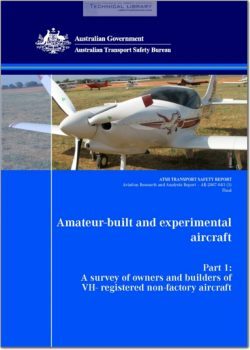ATSB-AR-2007-043(1)

- Version
- 164 Downloads
- 5.17 MB File Size
- 1 File Count
- August 9, 2016 Create Date
- August 9, 2016 Last Updated
Amateur Built and Experimental Aircraft - Part 1; A Survey of Owners and Builders of VH Registered Non Factory Aircraft

In the last three decades, both in Australia and overseas, there has been significant
growth in the number of amateur-built and experimental (ABE) aircraft. The nature
of amateur-built aircraft has changed significantly since 1955, when the Ultra Light
Aircraft Association of Australia (ULAAA) was formed. By modern standards,
most early aircraft would be classified as ultralights1 (Rogers, 1978), a term that
embodied amateur—built aircraft until 1998. Today, ABE aircraft may include twin
engine, j et-powered, high performance aircraft, and carry up to six people. This
moves beyond the traditional scope of ultralights.
Amateur—built and experimental aircraft continue to become more popular and
cement their role as an integral part of general aviation (GA) in Australia and
overseas, but there has been little formal study of ABE aircraft and their owners
worldwide, and no formal study of amateur—built aircraft owners in Australia.
Operational and demographic data on ABE aircraft is largely incomplete in
comparison to data held for other types of aircraft.
This report is Part 1 of a two—part series that examines non—factory amateur—built
and experimental aircraft in Australia. It looks at the ABE aircraft community,
including pilots and their aircraft, regulatory changes, and growth and development
of aircraft associations over time. Data for this report was gathered using a survey
sent to owners and builders of flying VH-registered ABE aircraft.
This report will allow aviation regulators and ABE associations to better understand
the needs and activities of ABE aircraft designers, builders, operators and
maintainers. This, in turn, will help to foster a safe, highly-skilled, and well-
represented amateur-built aircraft community. The demand for new low-cost
aircraft in GA may be partially met by ABE aircraft. Better information on the
decision processes used by ABE aircraft owners when selecting, buying, building,
testing, transitioning to, operating, and maintaining their aircraft, will help to inform
people thinking about becoming involved in this progressive area of aviation. The
results of this report will also be used to provide context for the study of ABE
safety trends and issues in Part 2 of this series.
| File | Action |
|---|---|
| ATSB-AR-2007-043(1) Amateur Built and Experimental Aircraft - Part 1; A Survey of Owners and Builders of VH Registered Non Factory Aircraft.pdf | Download |

Comment On This Post